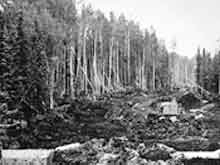

Famous Cases | Historical Tales | Vampires | Zombies
 |  |
Famous Cases | Historical Tales | Vampires | Zombies |
 |
| Caribou, Alaska, 1900 |
Forty-one years later, an advance team of ten Army Engineers arrived in Caribou as part of one of the great road-building feats in history: the Alcan Highway, the passage that would finally connect Alaska with the lower 48 United States. The Army engineers were experts in demolition: they had come to Caribou to blast a passage through a mountain pass and clear the way for the road builders, who were to arrive a few days later. On June 11th, 1942, the team erected tents just outside of the ghost town and set to work with renewed vigor, as the highway project was in its final stages.
Incident: At 11:43 pm on the night of June 13th, 1942, Project Headquarters in Whitehorse, Canada, received an urgent radio message from the Caribou camp. In the brief message, a terrified-sounding man claimed that the camp was under siege from a pack of vampires. The message was cut short, and Headquarters was unable to raise the camp on the radio over the next twenty-four hours. The FVZA office in Seattle was notified.
 |
| Construction along the Alcan Highway, 1942 |
The assault team found the ten Army engineers sleeping in their tents; all had recently been transformed into vampires. After the engineers were trapped, examined and destroyed, the assault team's dogs picked up a scent and led the team to an abandoned mine near the camp. Five vampires were flushed from the mine, examined and destroyed.
An examination of the clothing and personal effects of the vampires found in the abandoned mine revealed that the five must have been infected and transformed during the Caribou Gold Rush of 1899-1901. Somehow, the vampires had come back to life after an unprecedented forty-year dormancy.
Post-Mortems: A check of past FVZA records failed to turn up any reported vampire encounters in Caribou. Further research led to a story in "Young Klondike," a popular magazine of the period. Each issue of "Young Klondike" was filled with often fanciful stories of the characters and events of the Alaska Gold Rush. The April, 1902, edition contained a story entitled, "My Encounter With Vampires," a first-person account by prospector Josiah Franklin concerning events that transpired in Caribou in the winter of 1901:
"People started going missing. Every morning, one, two folks was gone. At first we didn't think nothing of it, that's how things was in Caribou. People left. Then one night, Pete Dawson, the owner of the saloon, came running down the street hollering, waking everyone up. He said he'd been attacked by vampires, said he barely got away, and from the looks of him, with his clothes all torn up, he wasn't lying. So about twenty of us got together, waited till the sun came up, then we went looking for them. We checked all over, every building, every miner's camp. Found nothing.If Mr. Franklin's account is true, then it might explain what happened to the Army engineers. Trapped in the chill depths of the mine on that night in 1901, the vampires likely were frozen solid. And they probably would have remained that way forever, had the Army engineers not arrived forty years later. In the course of blasting their way through the mountain pass, the engineers apparently opened up the entrance to the mine. As it was summer, the vampires must have been thawed out, after which they awoke, and eventually found their way to the camp.
That night, we drank us some coffee, hid in an alleyway and waited for them. Must have been after midnight when they came in. First there was this one man, a feller I recognized who had a claim out on Spring Creek. He came creeping through, like he was the scout or something. Then the rest of them came out of the shadows without even making a sound. There was five in all. We lit our torches and tried to surround them, but they turned tail and disappeared. Good thing we had dogs, because we would have never been able to catch up with them ourselves.
Young Klondike
MagazineWe found the dogs outside one of the abandoned mines and from the way they was barking we knew the vampires was in there. Problem was, none of us wanted to go in and finish the job. So we decided to blow up the entrance to the mine and trap them for good. We rigged up some dynamite and blew it up and a whole big bunch of rocks came crashing down around the entrance. I don't reckon a team of elephants could have cleared those rocks away. After that, we went back to the saloon and celebrated. And we never saw no vampires again."
Comments from Dr. Pecos: With their often remote locations and reputation for lawlessness, mining towns were notorious breeding grounds for vampires. Residents of these towns often had no choice but to take matters into their own hands, and this case was no different. The locals thought the problem was over when they sealed the vampires in the mine. Subsequent events proved how wrong they were.
This case underscores the importance of retrieving vampire bodies, no matter how unlikely their survival. History has proven that vampires can survive fires, shootings, explosions...and being frozen alive.